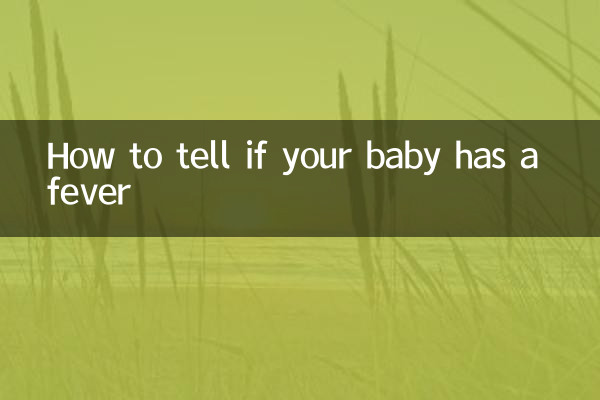How to tell if your baby has a fever
Baby fever is one of the biggest concerns for parents, especially new parents, who are often confused about how to determine whether their baby has a fever. This article will combine the hot topics and hot content on the Internet in the past 10 days to provide you with structured data and analysis to help you accurately determine whether your baby has a fever and master the correct treatment methods.
1. Common symptoms of fever in babies

Fever is the body's natural response to infection or disease, but babies cannot express discomfort in words. Parents need to judge by observing the following symptoms:
| Symptoms | Description |
|---|---|
| Increased body temperature | The normal body temperature range is 36.5°C-37.5°C. If it exceeds 37.5°C, it may be a fever. |
| facial redness | The baby's cheeks are red, especially at the base of the ears |
| restless | The baby keeps crying and is difficult to comfort |
| decreased appetite | Refusal to eat or milk intake significantly reduced |
| Lethargy or lethargy | Your baby seems particularly tired or unresponsive |
2. How to accurately measure your baby’s temperature
Measuring body temperature is a key step in determining whether your baby has a fever. The following are commonly used measurement methods and precautions:
| Measurement method | normal range | Things to note |
|---|---|---|
| Armpit temperature measurement | 36.5°C-37.5°C | Dry your armpits for 5 minutes before measuring |
| Oral temperature measurement | 36.2°C-37.3°C | Suitable for older children, need to hold for 3 minutes |
| Ear thermometer measurement | 35.8°C-38°C | Need to align the ear canal and measure quickly |
| Forehead thermometer measurement | 35.8°C-37.8°C | Affected by the environment, multiple measurements are required |
3. Graded treatment of baby’s fever
Depending on the level of body temperature, baby fever can be divided into different levels, and the treatment methods are also different:
| body temperature range | fever level | Handling suggestions |
|---|---|---|
| 37.5°C-38°C | low fever | Drink more water, cool down physically, and observe closely |
| 38.1°C-39°C | moderate fever | Take antipyretics and continue to observe |
| 39.1°C-40°C | high fever | Seek medical attention immediately to avoid seizures |
| Above 40°C | Very high fever | Emergency medical attention, danger sign |
4. The correct method of physical cooling
For low-grade fever or combined with drug treatment, physical cooling is a safe and effective method:
| method | Operational points | Things to note |
|---|---|---|
| Warm water bath | Wipe neck, armpits and groin with warm water at 32°C-34°C | Avoid alcohol baths to prevent allergies |
| antipyretic patch | Apply to forehead or neck | Pay attention to skin reactions and replace them promptly |
| Reduce clothes appropriately | Wear light and breathable clothing | Avoid over-wrapping that may cause body temperature to rise |
| Drink more warm water | Replenish water in small amounts and frequently | Prevent dehydration and promote perspiration |
5. When you need immediate medical attention
While most fevers can be monitored at home, the following conditions require immediate medical attention:
| red flag | Description |
|---|---|
| Fever in infants under 3 months old | Newborns with weak immune systems are at high risk |
| A high fever that lasts for more than 24 hours | There is no relief when the body temperature is above 39°C |
| Have convulsions | Febrile seizures require emergency treatment |
| accompanied by rash | May be a symptom of severe infection |
| extremely depressed | Unable to wake up or unresponsive |
6. Daily measures to prevent fever in babies
Prevention is better than cure. You can reduce your baby’s risk of fever through the following methods in daily life:
| measures | Specific methods |
|---|---|
| Vaccination | Complete immunization program vaccines on time |
| hygiene habits | Wash your hands frequently and pay attention to food hygiene |
| Dress wisely | Adjust clothing thickness according to weather |
| Enhance physical fitness | Appropriate outdoor activities and balanced nutrition |
| Avoid contact with the source of disease | Avoid going to crowded places during flu season |
Through the above structured data and detailed instructions, we hope that parents can scientifically determine whether their baby has a fever and take correct response measures. Remember, when you are unsure or the situation is serious, you should consult a professional doctor in time and never deal with it blindly.

check the details

check the details